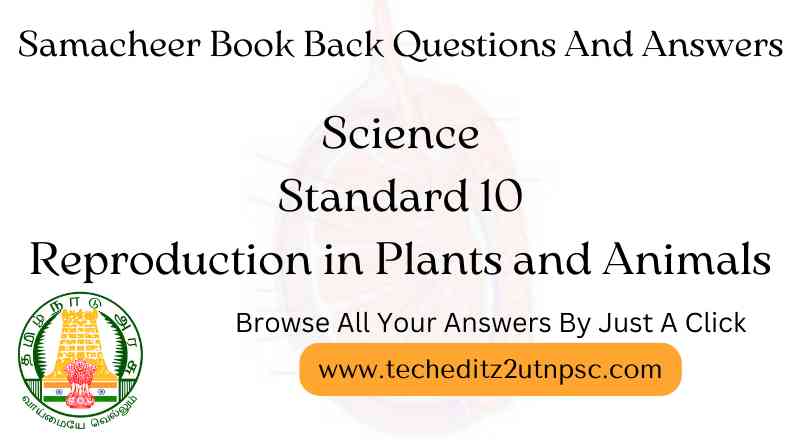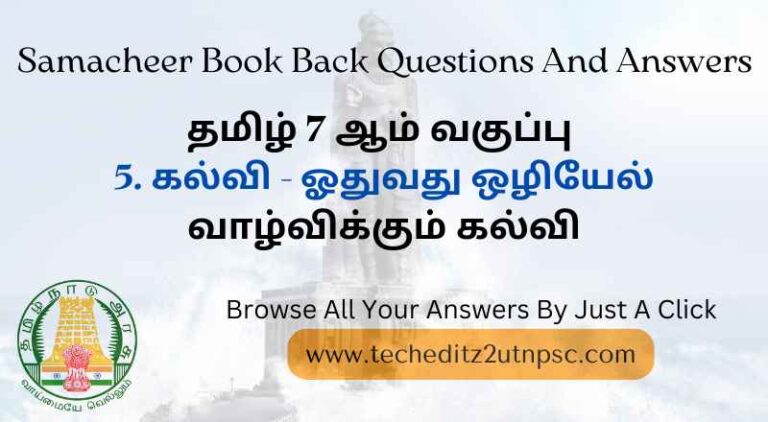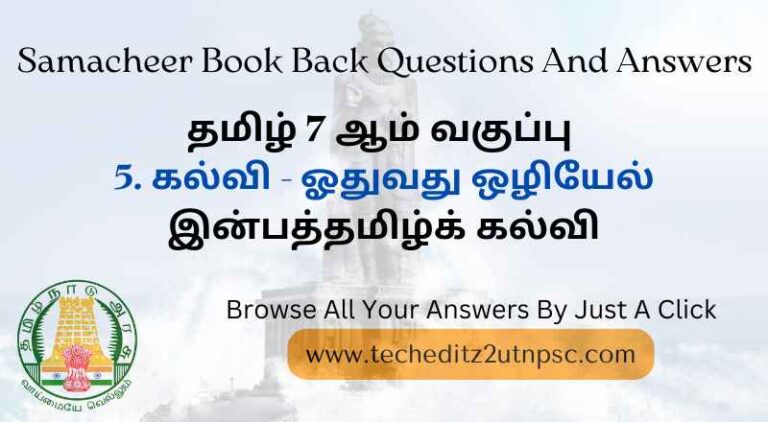support@techeditz2utnpsc.com | 8300-921-521

Reproduction in Plants and Animals
Samacheer Book Back Questions And Answers For Science Standard 10 “Reproduction in Plants and Animals“
I. Choose the correct answer:
1. The plant which propagates with the help of its leaves is _____.
a) Onion
b) Neem
c) Ginger
d) Bryophyllum
2. Asexual reproduction takes place through budding in _____.
a) Amoeba
b) Yeast
c) Plasmodium
d) Bacteria
3. Syngamy results in the formation of _____.
a) Zoospores
b) Conidia
c) Zygote
d) Chlamydospores
4. The essential parts of a flower are _____.
a) Calyx and Corolla
b) Calyx and Androecium
c) Corolla and Gynoecium
d) Androecium and Gynoecium
5. Anemophilous flowers have _____.
a) Sessile stigma
b) Small smooth stigma
c) Colored flower
d) Large feathery stigma
6. Male gametes in angiosperms are formed by the division of _____.
a) Generative cell
b) Vegetative cell
c) Microspore mother cell
d) Microspore
7. What is true of gametes?
a) They are diploid
b) They give rise to gonads
c) They produce hormones
d) They are formed from gonads
8. A single highly coiled tube where sperms are stored, get concentrated and mature is known as
a) Epididymis
b) Vasa efferentia
c) Vas deferens
d) Seminiferous tubules
9. The large elongated cells that provide nutrition to developing sperms are
a) Primary germ cells
b) Sertoli cells
c) Leydig cells
d) Spermatogonia
10. Estrogen is secreted by
a) Anterior pituitary
b) Primary follicle
c) Graffian follicle
d) Corpus luteum
11. Which one of the following is an IUCD?
a) Copper – T
b) Oral pills
c) Diaphragm
d) Tubectomy
II. Fill in the blanks:
1. The embryo sac in a typical dicot at the time of fertilization is _____.
2. After fertilization the ovary develops into _____.
3. Planaria reproduces asexually by _____.
4. Fertilization is _____ in humans
5. The implantation of the embryo occurs at about _____ day of fertilization
6. _____ is the first secretion from the mammary gland after child birth
7. Prolactin is a hormone produced by _____.
Answers:
1. 7 celled
2. fruit
3. Regeneration
4. Internal
5. 7th
6. Colostrum
7. pituitary gland
III (a) Match the following:
1. Fission A. Spirogyra
2. Budding B. Amoeba
3. Fragmentation C. Yeast
Answers:
1. B
2. C
3. A
(b) Match the following terms with their respective meanings
1. Parturition A. Duration between pregnancy and birth
2. Gestation B. Attachment of zygote to endometrium
3. Ovulation C. Delivery of baby from uterus
4. Implantation D. Release of egg from Graafian follicle
Answers:
1. C
2. A
3. D
4. B
IV. State whether the following statements are True or False. Correct the false statement
1. Stalk of the ovule is called pedicle.
2. Seeds are the product of asexual reproduction.
3. Yeast reproduces asexually by means of multiple fission.
4. The part of the pistil which serves as a receptive structure for the pollen is called as style.
5. Insect pollinated flowers are characterized by dry and smooth pollen.
6. Sex organs produce gametes which are diploid.
7. LH is secreted by the posterior pituitary.
8. Menstrual cycle ceases during pregnancy.
9. Surgical methods of contraception prevent gamete formation
10. The increased level of estrogen and progesterone is responsible for menstruation.
Answers:
1. False (Stalk of the ovule is called funicle)
2. False (Seeds are the product of sexual reproduction)
3. False (Yeast reproduces asexually by budding)
4. False (The part of the pistil which serves as a receptive structure for the pollen is called stigma)
5. False (Wind pollinated flowers are characterized by dry and smooth pollens)
6. False (Sex organs produce gametes which are haploid)
7. False (LH is secreted by the anterior pituitary)
8. True
9. False (Surgical methods of contraception prevent fertilization)
10. False (The decrease in level of estrogen and progesterone is responsible for menstruation)
Visit Our YouTube Channel For More Free Videos: Click Here


